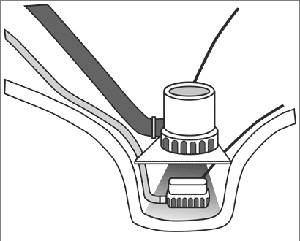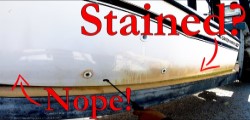Virtually all boats end up with unwanted water in the bilge, which must be removed. Water gets in from a propeller shaft packing gland, a leaky portlight, leaky seams in a wood boat, melting ice from the icebox and a multitude of other sources. Leaving large amounts of water in the bilge can have several undesirable effects on your boat, including destabilizing it, lifting spilled fuel and distributing it throughout the bilge (where it can attack, among other things, the insulation on electrical wiring) and promoting the development of osmotic blisters in fiberglass hulls. And did we mention having the boat sink? Getting this water (we call it nuisance water) out of your boat is the primary function of a bilge pump.
In some cases the leak may be of a catastrophic nature caused by a hole in the hull from a collision or a wave taken on board in a storm. These situations call for very large pumping capacity. In many cases the largest pumps will only buy you a little time to effect repairs to the leak, limp back to shore or make preparations to abandon ship. For emergency situations like this, it is advisable to have multiple electric pumps and at least one high-capacity manual diaphragm pump.
Therefore, we’d like to reinforce the following words of wisdom regarding bilge pumps so you’re not disappointed in the future:
Virtually no boat has a bilge pump system which is large enough to keep up with a leak caused by hull damage. Bilge pumps are designed for small quantities of water and are not damage control pumps like the ones Coast Guard helicopters drop. The American Boat and Yacht Council standards for electric bilge pumps state that they are "intended for control of spray, rain water and normal accumulation of water due to seepage and spillage."
Never leave a boat with a known leak alone with an automatic bilge pump in the hope that it will keep your boat afloat.. If your boat has a leak, get it fixed or haul out the boat. Don’t depend on a pump!
 |
3500 gph (or bigger) pump connected to manual switch.
400 gph (or smaller) pump with integral float switch, connected directly
to battery. |
Manual or Electric
High-capacity centrifugal pumps are relatively inexpensive and the easiest pumps
to install, but they are rendered ineffective if your boat’s electrical
system fails, and this is a likely occurrence if your boat takes on a lot of
water. For this reason we recommend that, in addition to any electric pumps,
you have at least one high-capacity manual diaphragm pump.
Manual pumps can move substantial amounts of water (20 gallons per minute or so), but they are very tiring to use. Each gallon of water weighs over 8lb. and pumping it 15’ or so is a challenging task for both the pump and the pumper. This is especially true if the pump’s location requires you to be on “all fours” or in some awkward position while pumping. Buckets may actually be more effective.
Automatic operation can be accomplished using either an automatic pump or an external float switch. As we mentioned above, automatic pumping should not be depended upon to keep a very leaky boat afloat, but it is very convenient. One disadvantage of using an automatic pump is that you may not be aware of your pump’s operation if you develop a steadily increasing leak. For example, your boat may have a brass gate valve that has become damaged from its loss of zinc through electrolysis.
If an automatic pump cycles on and off without your knowledge, you could be unaware of the leak before it becomes catastrophic and beyond the capacity of the pump. There are two solutions to this problem: Use a cycle counter to record how often your pump turns on and off. Log it. Alternatively, have a light or buzzer that turns on when your pump is energized to show you when it’s in operation.
What to look for
- Integral automatic switches: Many pumps are available with a float switch pre-wired to the side of the pump. This makes it simpler to install, especially in tight vertical bilges. Another way to accomplish this is with the Rule Automatic Bilge Pumps, which spin their motors every few minutes and use the current draw from the motor to detect whether there is water present. This has the minor disadvantage of running the motor whether there’s water present or not.
- Electronic switches: Some newer switches can sense the presence of water through their plastic housing. They also do not sense petroleum products, so you won't accidentally pump fuel overboard if it is spilled in the bilge.
- Centrifugal pumps are submersible and non-self-priming, so they must be sitting in the water in order to pump it, and can usually remove all but the last inch of water. They work the best when the bilge has a small sump where water collects. Centrifugal pumps use whirling vanes to draw fluid into the center of the pump and then push it outward from the center through an outlet port. They have a built-in strainer in their base that can be removed quickly for cleaning, which is important because the small impeller can get clogged with debris.
- Diaphragm pumps are self-priming, which means they can lift water up an intake hose and expel it outside the hull. They use a membrane to increase and decrease the volume of a pumping chamber, drawing fluid in and pushing fluid out through a set of one-way check valves. Diaphragm pumps require an external strainer at the end of the intake hose, since a small amount of hair or bilge debris can cause the valves to clog.
- Flow restrictions: Diaphragm pumps try to move the same volume continuously. If something restricts the flow, they work harder and harder until they stop pumping, at which point something usually fails. Centrifugal pumps respond to increased head pressure by moving less and less fluid until they stop pumping. The motor will not burn up, but the pump will stop moving any fluid.
- The challenge of getting water overboard: The effect of siphoning occurs when a hose is led to a body of water above the starting point. If this water ever starts to flow backwards it produces suction, that draws water into the boat. This is one reason why bilge pump discharges frequently exit high on the hull, well above the waterline. A vented loop can also be used to prevent back-siphoning.
- Keeping the intake clean: A strainer or strum box is used on the intake end of the hose, to prevent debris from clogging the pump or hose. Bilges are full of junk more often than not, so bilge pumps must be easy to clear and clean. The valves in some diaphragm bilge pumps are designed to pass objects as big as a marble, but hair and fiberglass strands are very difficult to defend against.
Qualifying Questions
What type of boat do you have? A small racing keelboat that sees lots of rough water action will need a better pump system than a large powerboat that is mainly operated on a calm lake. Here are some suggestions:
- Daysailors and open outboard powered skiffs generally use a portable piston pump, bucket or hand bailer.
- Runabouts and ski boats use a single submersible electric pump in the stern or in the lowest point in the bilge. Boats with stern drives may have the pump under the oil pan of the engine.
- Small cruising and racing sailboats can use one large diaphragm bilge pump mounted in the cockpit.
- Offshore racing sailboats are required by the Special Regulations to have two manually operated pumps; one operable from the cockpit and one operable from down below. They have to be permanently installed.
- Coastal and offshore boats will generally want automatic electric bilge pumps located in each compartment (bilge area) that can hold water, and a large manual pump for backup.
What size boat do you have? Electric bilge pumps are rated by their capacity, measured in gallons per hour, under open flow conditions with no restrictions to the discharge. The rule of thumb is to get the largest model that is practical for the boat. Your selection will depend on size constraints and power limitations, but you should choose a 1000 gph model or larger, if possible. Submersible pumps general have higher capacity.
Do you have to replace an existing pump? Match existing hose sizes and wire capacity, unless you want to upgrade the wiring and the thru-hull size too. Buy the largest capacity pump that uses the same hose diameters. For a few dollars more you can increase pump capacity significantly and still keep the same hose diameter. For a new installation, use the largest practical pump size.
What components are required? A complete installation of electric bilge pumps requires several components:
- The pump itself.
- A connection to the boat's battery.
- A switch to be turned on and off. Most pumps will utilize a manual on/off switch, a float switch, or both. A float switch automatically activates the pump once the water level rises above a certain point and turns the pump off when the water level falls.
- An intake hose, if you are installing a diaphragm pump, leading from the lowest possible spot in the bilge to the pump. It can be a corrugated hose, especially when the pump is mounted high above the bilge.
- A discharge hose, which should be smooth leading from the pump to the thru-hull for overboard discharge of the extracted water.
- Thru-hull fitting above the waterline.






















